After becoming the first team to repeat as Stanley Cup Champions in the salary cap era, the Pittsburgh Penguins entered the 2017-18 season with the chance to three-peat, the first opportunity since the 1980-83 New York Islanders. In the offseason, they lost Nick Bonino, Chris Kunitz, Marc-Andre Fleury, Matt Cullen and Trevor Daley. It didn’t help that they opened the season without a legitimate third-line center, going with Greg McKegg behind Sidney Crosby and Evgeni Malkin.
The team looked to be out of gas for most of the first half in 2017-18, ranked 7th in the Metropolitan Division with an 18-16-3 record (49 points) and a minus-14 goal differential as of Christmas Day. After the break, their fortunes changed. finishing out the season in second place in the Metro with a 47-29-6 record (100 points) and a plus-22 goal differential.
Despite the turnaround, inconsistent playoff performances from the blue line, the bottom-six and the goalies led to a six-game second-round playoff loss to the Washington Capitals.
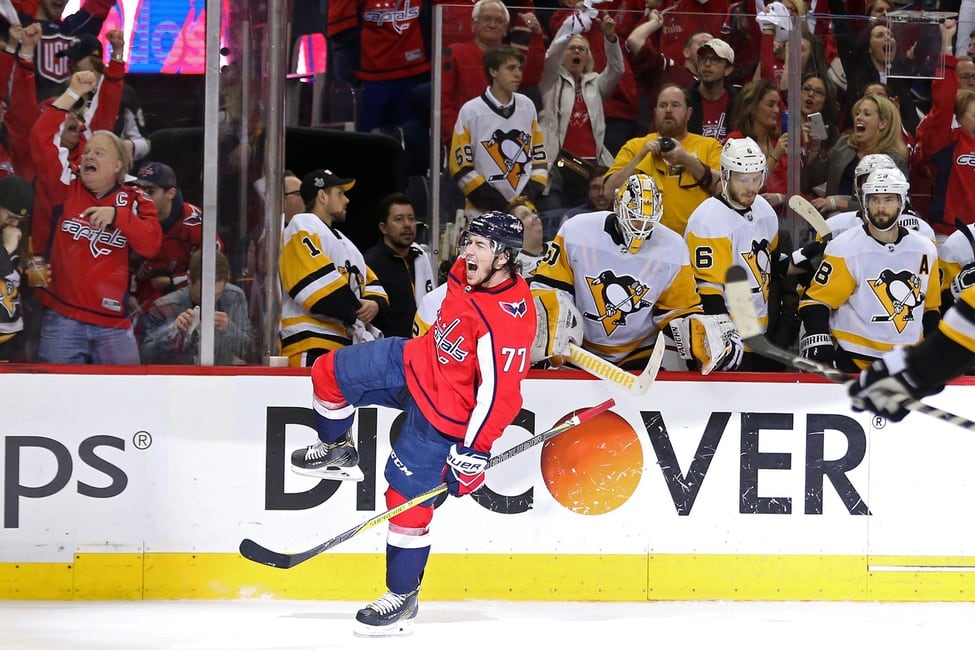
In Pittsburgh, it’s disappointing any time the team doesn’t go all the way. Alternatively, it means the team will be rested and motivated to reclaim hockey’s holy grail. As captain Sidney Crosby said earlier this month:
It’s good to get a full summer in and train. I think probably more mentally than anything, it’s coming in fresh, knowing that you lost the year before and want to prove something.
Do the Penguins have what it takes to win their third Stanley Cup in four years?
2017-18 record: 47-29-6, 100 points (2nd in Metropolitan Division, 5th in Eastern Conference, 10th in NHL standings)
Offseason Moves
Notable Organizational Additions
- Jack Johnson (LD) — 31 — UFA (Columbus)—five years, $3.25 million per
- Matt Cullen (C) — 41 — UFA (Minnesota)—one year, $650,000
- Derek Grant (C) — 28 — UFA (Anaheim)—one year, $650,000
- Jimmy Hayes (RW) — 28 — UFA (New Jersey)—one year/two-way, $650,000
- Stefan Elliott (RD) — 27 — UFA (HV71, SHL)—one year/two-way, $650,000
- Filip Hållander (C/W) — 18 — Drafted 58th overall (2018) Timrå IK (Allsvenskan)—signed three-year ELC
- Calen Addison (D) — 18 — Drafted 53rd overall (2018) Lethbridge Hurricanes (WHL)
- Juuso Riikola (D) — 24 — UFA (KalPa, Liiga) Signed one-year, entry-level contract
The biggest addition is, of course, Johnson. The 31-year-old defenseman struggled last season with the Columbus Blue Jackets and was scratched for all six playoff games. The Penguins are hoping he’ll rebound and play better under Mike Sullivan’s system while proving himself as a steady stay-at-home option on the second or third pair.
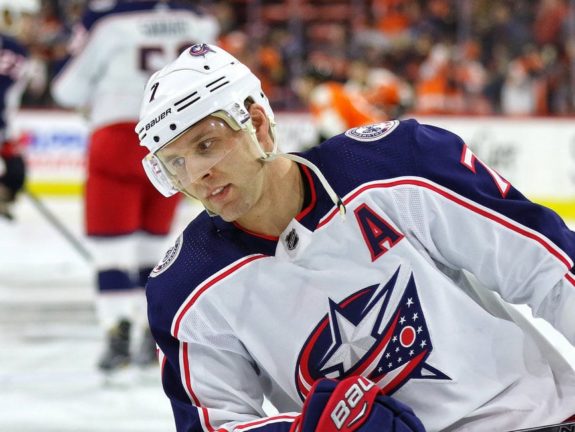
Notable Organizational Losses
- Tom Kuhnhackl (RW)—Signed with New York Islanders
- Carter Rowney (C/W)—Signed with Anaheim Ducks
- Josh Jooris (C)—Signed with Toronto Maple Leafs
- Christian Thomas (RW)—Signed with Rögle BK (SHL)
- Conor Sheary (LW)—Trade (Buffalo Sabres)
- Matt Hunwick (LD)—Trade (Buffalo Sabres)
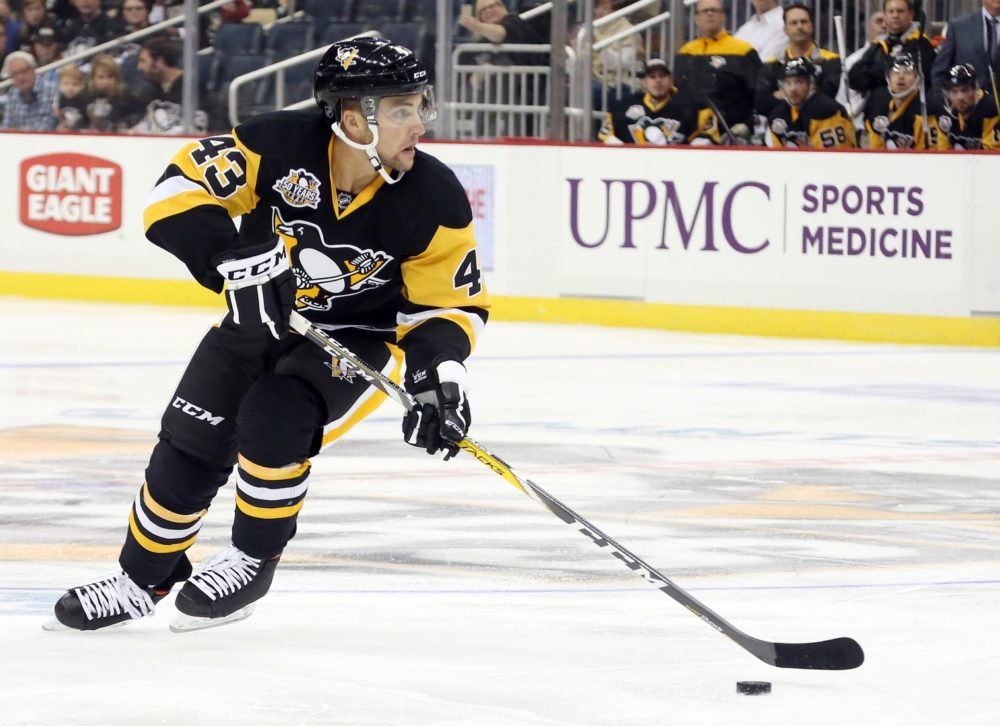
In comparison to the 2017 offseason, the Penguins lost few key pieces this summer. Losing Sheary’s production (18 goals) will hurt. Although, possession blackholes Kunhackl and Rowney who combined for 15 points last season will help the team by their absence from the bottom-six, as it will open up spots for younger, more talented players.
The Penguins’ 2018 Draft
For the fourth draft in a row, the Penguins didn’t have a first-round pick, which as traded, along with netminder prospect Filip Gustavsson, a 2019 third-rounder and defensemen Ian Cole, to the Ottawa Senators in exchange for Derick Brassard before the trade deadline.
While the team didn’t have a selection until the back half of the second round, it didn’t stop general manager Jim Rutherford and co. from getting two potential impact players in Calen Addison and Filip Hållander.

Addison was selected 53rd overall after putting up 65 points in 68 games during his draft year with the Lethbridge Hurricanes of the WHL. The 18-year-old is an offense-first type of defenseman and a smooth skater with the ability to run a power play. His profile is similar to Kris Letang’s, though he’s smaller at 5-foot-10, 179lb and could bulk up a bit. Addison also needs to improve his play without the puck, but this is common with most junior defensemen. His NHL ETA is 2021-22, and if he continues to develop properly he could be a second-pairing defenseman in Pittsburgh.
Related: Calen Addison Draft Profile
Hållander was selected 58th overall by the Penguins, who traded the 64th and 146th picks to make sure they got their man. The 18-year-old recorded 20 points in 40 games with Timrå AK of Allsvenskan. He totalled two points in nine qualification games to help Timrå get promoted to the SHL—the top Swedish league—for the 2018-19 season. The points may not be eye-popping, but Hållander played injured for a majority of the season and it impacted his play. A full and healthy season will help him develop in the right direction.
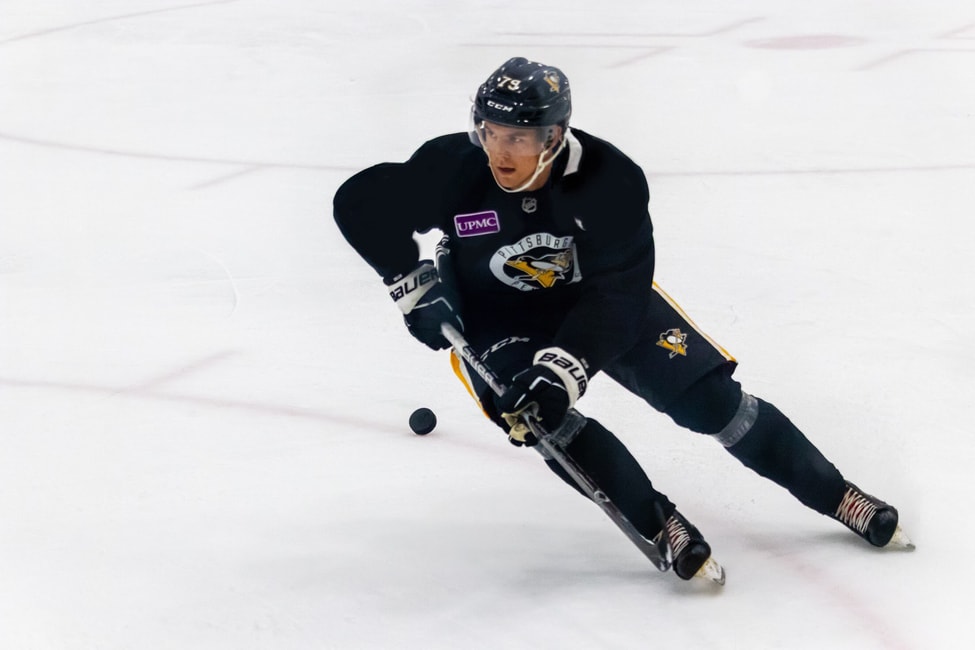
Hållander is a good skater who’s an advanced defensive forward for his age. He compares his style of play to fellow Swede, Patric Hornqvist. He likes the offensive zone, creating scoring chances and isn’t afraid to get rough. Much like Addison, Hållander’s ETA is 2021-22 and he has the chance to be a 20-goal, 40-point middle-six forward.
The Penguins had two selections over the remainder of the draft: a fifth-round pick and a sixth-round pick. The fifth-rounder (129th overall) was used on Justin Almeida, a creative but undersized forward who recorded 98 points—43 goals, 55 assists—in 72 games with the Moose Jaw Warriors of the WHL as an overage player.
In the sixth round (177th overall) the team selected Liam Gorman, a 6-foot-3 center who recorded 33 points in 30 games with St. Sebastian’s School in Needham, MA. He’s committed to Boston University for the 2019-20 season but will likely spend the upcoming one with the Chicago Steel of the USHL.
With only four picks, the Penguins didn’t add any top tier talent but they did add four players who could make an impact in the future.
Projected Lines: Forwards
Age on Opening Night
Jake Guentzel (23) — Sidney Crosby (31) — Daniel Sprong (21)
Zach Aston-Reese (24) — Evgeni Malkin (32) — Phil Kessel (31)
Bryan Rust (26) — Derick Brassard (31) — Patric Hornqvist (31)
Carl Hagelin (30) — Riley Sheahan (26) — Dominik Simon (24)
Extra Forwards: Matt Cullen (41) and Derek Grant (28)
The Penguins will enter the 2018-19 season with plenty of youth flanking their centers, including Guentzel, Aston-Reese, Simon and Sprong who are all 24 or younger.
Related: Penguins’ Youth will Define 2018-19 Season
Head coach Mike Sullivan is known to shuffle his lines on a nightly basis or even during games. The club has forwards who will perform regardless of where they’re positioned, like Rust and Kessel, meaning the opening night lineup could look different from the lines five games into the season.
However, Crosby and Guentzel are locked in to begin the season together. It would be challenging to justify otherwise considering the success the pair had in the playoffs, combining for 42 points in 12 games.
Through the first two weeks of training camp and pre-season games, Sprong has joined Crosby and Guentzel on the right wing which could mean the 21-year-old is in a prominent position to put up big numbers if he can stick around.
Related: Penguins Need Daniel Sprong to Step Up
Derick Brassard
After joining the Penguins, Brassard had mixed results. On one hand, he had eight points—three goals, five assists—in 14 regular season games. On the other, he had just four points—one goal, three assists—in 12 playoff games, not what the Penguins signed up for. His playoff struggles could be linked to the groin injury that kept him out of the lineup for the final five games of the regular season, and to his limited ice-time (TOI) in the playoffs (13:29 per game).
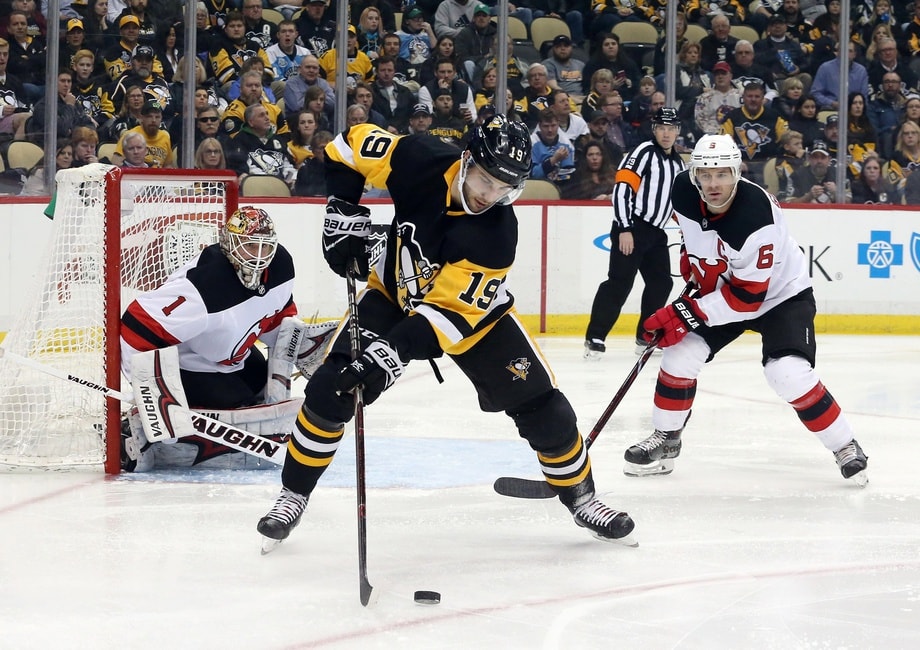
Most teams would slot Brassard in as their number two center, who receives top power-play time but with Crosby and Malkin ahead of him, that’s not the case. As head coach Mike Sullivan said:
He’s playing behind two generational talents and so because of that, he played a very different role than he’s accustomed to play.
This isn’t a knock on him, of course. It’s not often the same team has two future Hall-of-Famers at the same position. Brassard has said he’s willing to do whatever he can to help the team win, including moving to the wing. Although his best chance will be as a center, giving the Penguins unmatched depth down the middle.
For his career, Brassard has 428 points—162 goals, 266 assists— in 716 games, for an average of .59 points per game (PPG) or 49 points per season over his 11-year career. If the Penguins can get near a 50-point season from their third-line pivot, the rest of the league will have trouble stopping them.
Related: Penguins Have Unmatched Depth with Brassard
Zach Aston-Reese
Aston-Reese was a sought-after prospect after being named as a Hockey East First-Team All-Star and First Team All-American, along with winning the Hockey East Player of the Year and being a finalist for the Hobey Baker Award in his final year of college hockey for Northeastern.
Following interest from the Edmonton Oilers, Vancouver Canucks, Los Angeles Kings, Detroit Red Wings, San Jose Sharks and Penguins; Aston-Reese ultimately decided to sign a two-year, entry-level contract with Pittsburgh on Mar. 14, 2017.
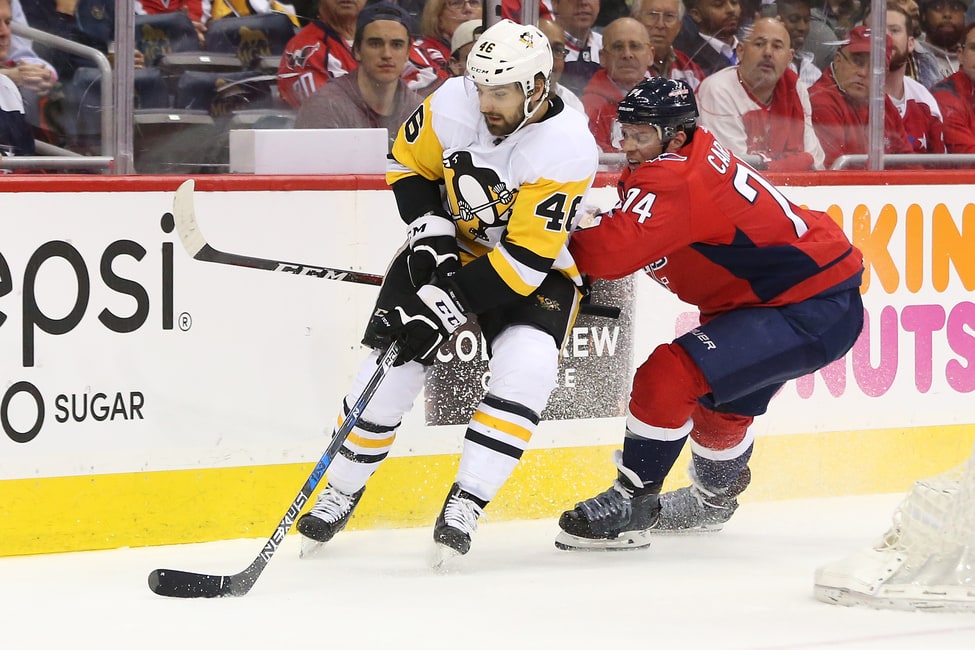
He started his professional career in the AHL to finish the 2016-17 season, scoring eight points in ten games before an injury cut his debut short. His first full pro season was in 2017-18 in the AHL. After recording 29 points in 41 games he was called up to the NHL on Feb. 3, 2018, and posted six points in 16 games while playing on almost every line. He added one point in nine playoff games before a controversial hit from Capitals forward Tom Wilson left him with a concussion and broken jaw that ended his season. Now fully recovered, Aston-Reese will shift his focus toward the upcoming season and earning a full-time NHL role.
In the past, he has been compared to the team’s resident pest, Hornqvist, and former Penguin Chris Kunitz. He’s willing to crash the net and go to the dirty areas in order to make plays for his linemates. Because he’s already 24, he’ll likely have less room for error than someone like Sprong and he’ll have to build on his play from last season if he hopes to keep his NHL spot. If he can, he could prove to be an important part of the Penguins’ middle six.
Related: Aston-Reese a Testament to Penguins New Era
Projected Pairings: Defensemen
Age on Opening Night
Kris Letang (31) — Brian Dumoulin (27)
Justin Schultz (28) — Jack Johnson (31)
Jamie Oleksiak (25) — Olli Maatta (24)
Extra Defensemen: Chad Ruhwedel (28)
The Penguins’ blue line has always been their weakest link. They have top-end talent in Letang, Dumoulin and Schultz, but they’ve been hurt by inconsistency and their weak third pairing. When Letang is on his game, he can mask many of the Penguins’ defensive shortcomings but when he’s off, the team is exposed. He struggled last season in his return from neck surgery, but with a full summer of rest, Letang enters 2018-19 healthy and will look to return to his elite form.
Related: Penguins’ Letang will Rebound in 2018-19
It was assumed Ruhwedel would be the seventh defenseman as he’s performed well in the role over the previous season and a half. But with Riikola’s strong training camp and preseason, Ruhwedel has competition. Sullivan said the following about Riikola after Saturday’s game against the Blue Jackets: “We’ll let the training camp play out. But certainly, he’s a guy that has raised eyebrows and he’s going to make decisions for the coaching staff very difficult.” Despite Sullivan’s praise, it’s likely Riikola begins the season in the AHL as it’ll give him the best chance to fully adjust to the North American game after spending his entire professional career overseas.
Jack Johnson
Signing Johnson to a five-year, $16.25 million contract on July 1 was puzzling, especially after a dismal final season with the Blue Jackets. The third-overall pick in 2005 has consistently been among the worst possession players in the league, never posting a five-on-five CF% above 49.75. He’s also been deployed like a top-four defenseman when he’s never been one, something the Penguins will hope to avoid.
To be fair, in Pittsburgh he won’t be asked to play 20 plus minutes a night which should help him. Sullivan’s system allows players to play to their strengths and it’s something Johnson hasn’t experienced in his career. He’s always been an above-average skater, doesn’t turn the puck over much and has some offensive upside, with four 30-point seasons to his name.
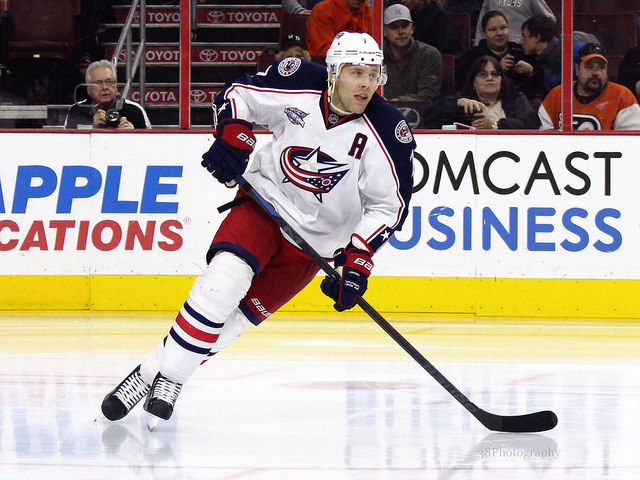
He’s projected to begin his Penguins career as a stay-at-home option beside Schultz on the second pairing, but Johnson will likely sacrifice a few shifts a game to Maatta. He could also help improve a penalty kill that ranked 17th in the league with an 80 percent success rate.
The Penguins would be more than happy if Johnson posts positive possession numbers, boosts the penalty kill and gives them 20-25 points while playing around 17 minutes a night. If not, there’s always the potential 2020 NHL expansion to relieve them of his $3.25 million cap hit.
Olli Maatta
After a number of injury-riddled and inconsistent seasons following his rookie campaign in 2013-14, Maatta seemed to finally find his stride in 2017-18. He played all 82 games for the first time in his career, recording 29 points (seven goals, 22 assists) and controlling 51.77 percent of the shot attempts at five-on-five while being the Penguins’ most consistent defenseman. He carried his regular season success into playoffs, as he was on the ice for just one goal against at five-on-five in 12 games.
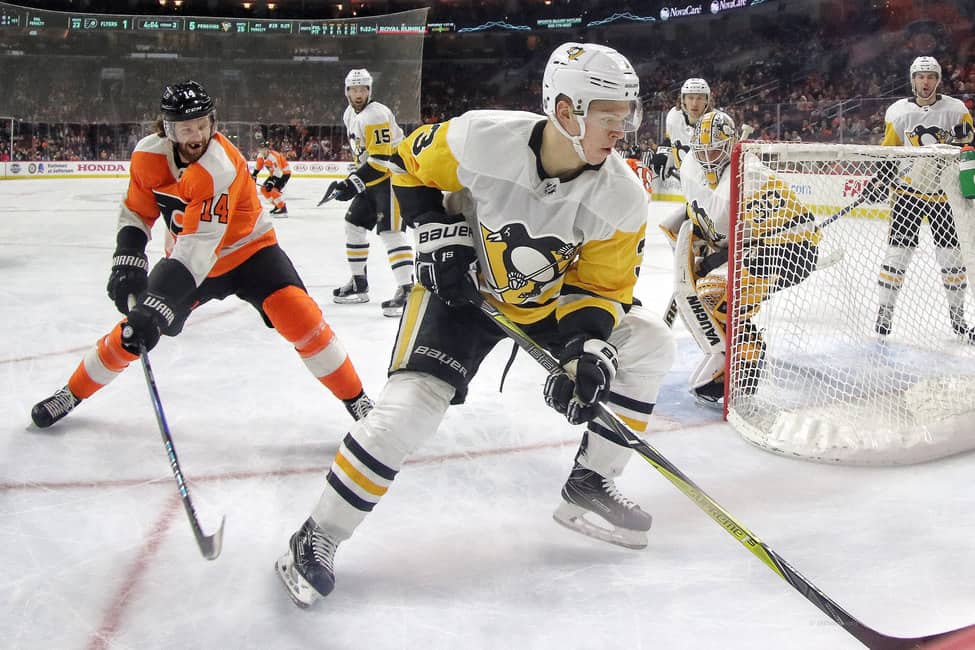
He’s formed a solid second pair with Schultz over the last two seasons but will begin the season paired with Oleksiak. Like any player coming off a breakout year, Maatta, 24, will have to prove 2017-18 wasn’t a fluke. Judging by his comments from earlier this month, Mattaa is ready. He also seems eager to add a third Stanley Cup to his trophy case:
“If you want to get better as a player, I know you’ve got to get selfish sometimes, but the most hunger comes out when you don’t do well as a team,” Maatta said. “You’re pretty much measured by championships. That’s what people are going to remember. That’s in the back of your head the whole time.”
Goaltending
Age on Opening Night
Matt Murray (24)
Casey DeSmith (26)
First Call-Up: Tristan Jarry (23)
At this point, the horse is dead and badly beaten, but it needs to be said again. The Penguins’ goaltending was a major issue last season. Starter Matt Murray struggled to stay healthy and dealt with the death of his father in January, en route to a 27-16-3 record with a .907 save percentage (SV%) and 2.92 goals against average (GAA) in 49 games.
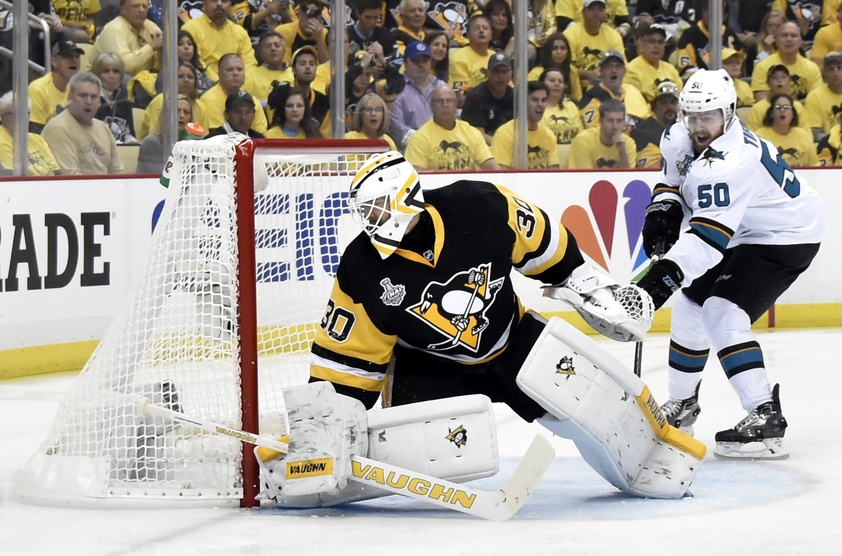
Top prospect Tristan Jarry earned some big minutes with the Penguins and had his moments but was inconsistent, leading to a 14-6-2 record with a .908 SV% and 2.77 GAA in 26 games. Free agent Antti Niemi was a colossal failure with a 0-3-0 record, .797 SV% and 7.50 GAA in three games before being waived. The team received its most successful play in net from Casey DeSmith who went 6-4-1 with a .921 SV% and 2.40 GAA in 14 games.
At five-on-five, the Penguins received a combined .913 SV% from Murray, Jarry and DeSmith. A significant drop from the team’s marks of .930 and .926 in 2015-16 and 2016-17, respectively. Overall, they had an all-situations team SV% of .906 compared to .921 and .917 marks in 2015-16 and 2016-17 which suggests that last season was an anomaly in net, and it shouldn’t be much of a problem in the long run.
Murray’s glove hand is often criticized and it’s justified when you look at his playoff performance. Young goalies tend to have their flaws and Murray is no exception. After not winning the Stanley Cup for the first time in his brief NHL career, he seems to have taken advantage of the extended summer to improve on his shortcomings. “Having a little bit of extra time gave me a good opportunity to step back and really look at my game objectively and realize when it’s not where it needs to be,” Murray said.
Murray helped the Penguins to two Cups before his rookie eligibility expired, so he has earned the chance at a clean slate entering the 2018-19 season.
As far as the backup spot goes, the Penguins have three goalies remaining in camp (Murray, Jarry and DeSmith), meaning they still haven’t made their decision as to who will back up Murray this season.
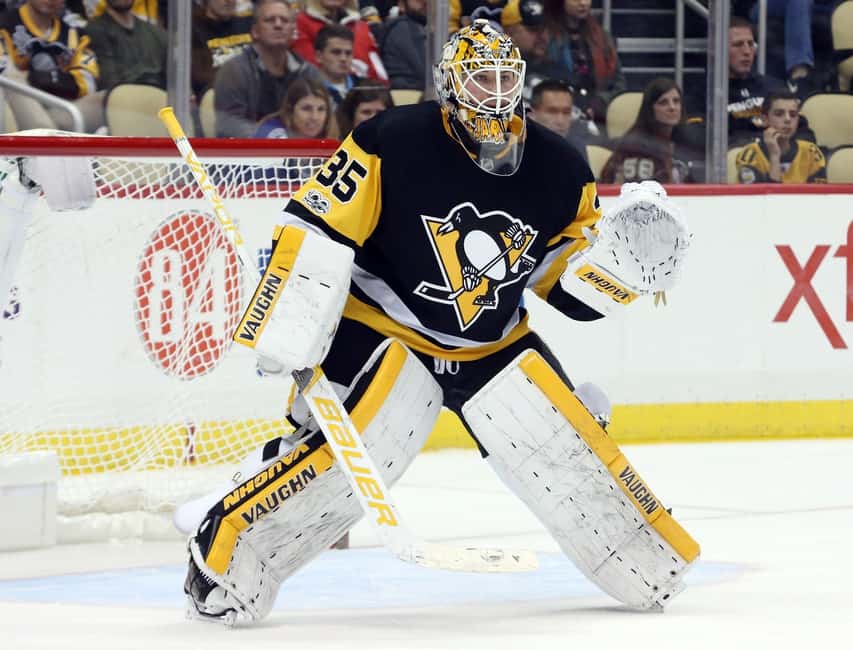
DeSmith had better numbers than Jarry last season but has struggled in the preseason, stopping just 36-of-42 shots for a .857 SV% in two games. Jarry has done his part to stake his claim, stopping 61-of-64 shots for a .953 SV% in two games. If one can claim the backup job and run with it, it’ll go a long way in helping the Penguins achieve consistency in net.
Related – Penguin’s Goalie Dilemma: Jarry or DeSmith?
Prospects Who Could Debut This Season
The Penguins rarely have a prospect in their system who is a bonafide first-line talent. That’s the cost of winning and striving to win for an extended period of time. That said, they have a considerable number of prospects who can contribute at the NHL level in a middle or bottom-six role and a few of them may earn time with the Penguins in 2018-19.
Adam Johnson
The Penguins have been successful with a number of college players in the past, so there’s no harm in going back to the well. Adam Johnson earned a professional contract after doing well at camp last season and posted 31 points (11 goals, 20 assists) in 70 AHL games. It’s not overly impressive but it’s solid for an undrafted free agent from the University of Minnesota-Duluth and he seemed to have improved at the annual prospects challenge earlier this month, posting three goals in three games. He also got in two preseason games and scored a goal in the second contest.
The 24-year-old is a versatile forward with a good shot and excellent speed. His skill set makes him a match for either Crosby or Malkin, but he’s best suited on the third or fourth line. He’ll need to be more consistent in his second season in the AHL if he’s going to receive a call-up. If he does, he should see time with the Penguins this season.
Teddy Blueger
Drafted 52nd overall in 2012, the Penguins had to wait a while for Blueger to make the leap to professional hockey, as he played four years of college hockey. His first full season was in 2016-17, where he recorded 31 points (seven goals, 24 assists) in 54 games with Wilkes-Barre. The 24-year-old took another step forward last season putting up 45 points (21 goals, 24 assists) in 70 games. His efforts earned him a promotion to the NHL, though he didn’t appear in any games.
Until the Penguins signed Cullen and Grant, it seemed management was sold on Blueger playing a depth or even fourth-line role with the club in 2018-19.
Sounds like Teddy Blueger will get a real shot this year. "He’s capable of being a fourth-line center," Rutherford said. "He’s at that point."
— Jason Mackey (@JMackeyPG) June 25, 2018
The native of Riga, Latvia, is a solid faceoff man, as well as a skilled two-way player and isn’t afraid to play a grinder-like game. His ceiling is likely as a fourth line center, but he could be a good one. Expect him to make his debut with the Penguins this season.
Related: Teddy Blueger Interview and Profile
Juuso Riikola
After being signed in May from KalPa of Liiga from Finland, Riikola’s career with the Penguins was supposed to begin in the AHL but his performance in training camp has given the coaching staff second thoughts. The 24-year-old has recorded two goals in four pre-season games while displaying his ability in all areas of the game, from even strength to the penalty kill to the power play.
Riikola has offensive talent, evidenced by his 49 points over his final two seasons overseas, and he’s a great penalty-killer. Overall, he doesn’t have first or second pairing potential, but he could slide in as an adequate bottom-pairing defenseman if called upon. Unlike Ruhwedel, Riikola is exempt from waivers so it’s likely he begins the season with Wilkes-Barre, but it shouldn’t be long before he finds himself in Pittsburgh.
Season Outlook: Stanley Cup or Bust
The Penguins enter the 2018-19 season in a prime position to win their third Stanley Cup in four years.
Down the middle, the Penguins may have the best depth in the league with Crosby, Malkin, Brassard, Sheahan and Cullen. Malkin is a legitimate top-three center and the Penguins have him on their second line after a 42-goal, 98-point season in 2017-18. The team could have one of Crosby, Malkin or Brassard on the ice for as much as 80 per cent of a game which would be challenging for opponents to defend against.
The Penguins also possess a collection of wingers that few teams can match in Kessel, Hornqvist, Rust and Guentzel. In fact, Hornqvist, who scored 29 goals last season, may not begin the season in the top six. It’s a significant difference from just five seasons ago when the Penguins were giving players like Brian Gibbons and Chris Conner extended time beside Crosby and Malkin.
With Malkin, Crosby, Kessel, Guentzel, Hornqvist and Brassard, the Penguins have six players likely to surpass the 20-goal milestone. Depending on how long Sprong lasts with Crosby, that number could be seven. Crosby, Malkin and Kessel could see their goal totals extend into the high 30s if they stay healthy.
The six likely 20-goal scorers will come close to or surpass the 50-point milestone as well. Last season, three players surpassed the 85-point mark: Malkin (98), Kessel (92) and Crosby (89). There’s a chance they repeat their success in 2018-19 if they play a complete season together again.

After shifting away from the philosophy that won them two straight Cups and bringing in offense-killing forwards on the third and fourth lines, the Penguins struggled to find consistent scoring from outside of their top two lines in 2017-18. With a projected new look bottom-six and arguably the deepest lineup of the Crosby and Malkin era, putting pucks in the net shouldn’t be an issue for the Penguins in 2018-19.
On defense, there are a number of questions to be answered. Will Letang return to his elite form? Will Maatta build off his breakout season? How will Johnson do during his first season in Pittsburgh?
The Penguins need Letang to return to the form he displayed throughout the first ten seasons of his career. If he does, he and Dumoulin have the potential to be one of the best pairs in the league. Letang’s value to the Penguins is often understated because he plays on the same team as Malkin, Crosby and Kessel. But if he’s on, he can change a game in such a way that makes the Penguins so much harder to play against.
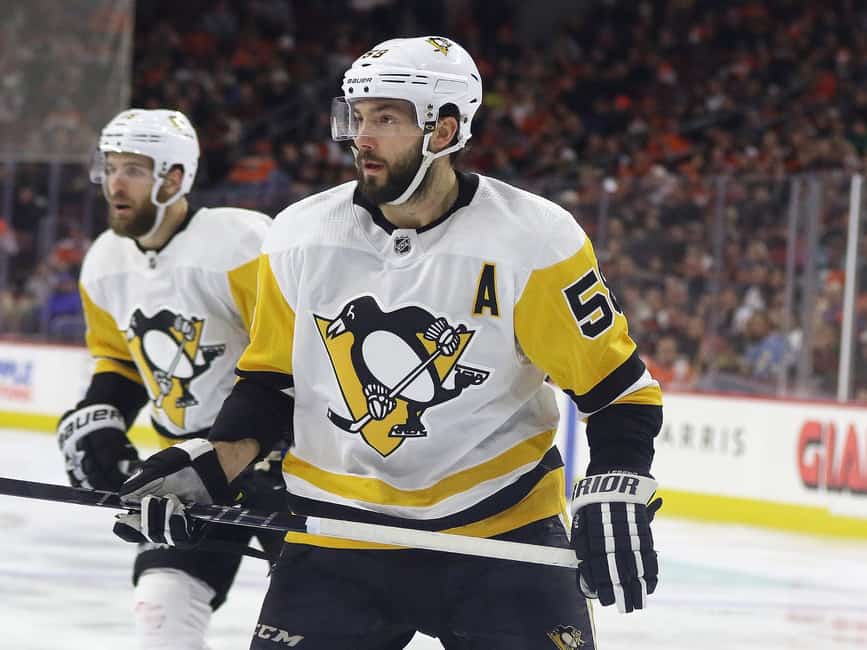
If Maatta can build off his 2017-18 performance, the Penguins will be in a position of strength. If he plateaus, he’ll still be a top-four defenseman who brings stability to a blue line. Albeit, if he plateaus he’ll be closer to a low-level number four than a high-level number four.
Expectations for Johnson should be low. He’s coming off the worst season of his career and is the oldest defenseman on the roster. While a reduced role could lead to positive results for both the team and Johnson, the return will be minimal.
As for goaltending, it’d be challenging to have a worse result than last season. Murray should bounce back, and while he’s not going to post a SV% in the high .920s, he’s much better. He should be expected to win 35 games while posting a high .910s to low .920s SV%. Additionally, if they can get stable play from either DeSmith or Jarry, it would go a long way to keeping Murray healthy throughout the season and which could pay off come playoff time.
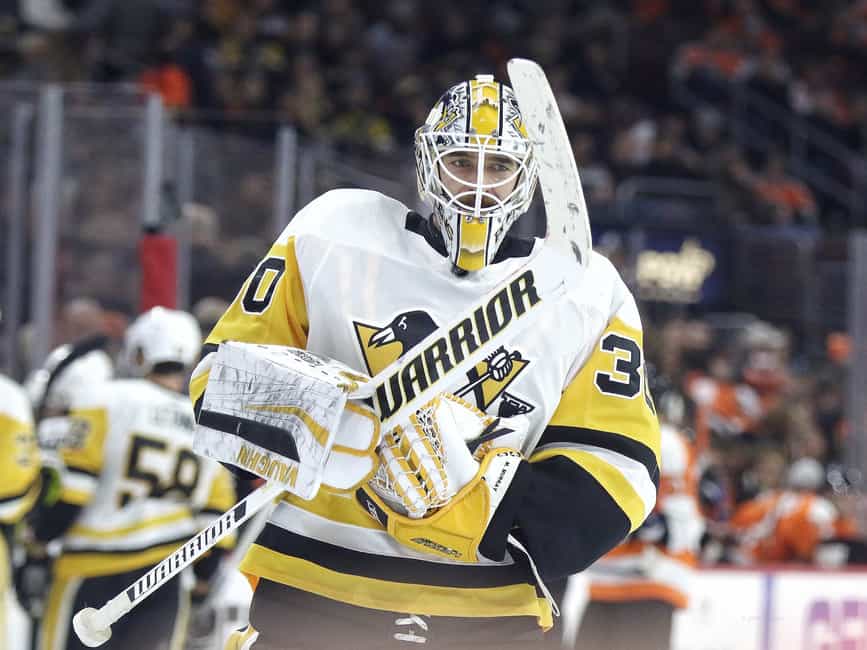
On paper, the Penguins have one of the deepest and best teams in the league. They have a shot at contending for the Presidents’ Trophy if they stay healthy, though the team and especially their stars have had trouble staying healthy over the years. However, Letang (79), Crosby (82), Malkin (78) and iron-man Kessel (82) all played full seasons in 2017-18. Staying injury-free could determine the team’s regular season success.
The Penguins have always found a way to win with injuries, and expectations won’t change in 2018-19. Winning their first Metropolitan Division title since 2013-14 along with a finish in the top three in the Eastern Conference isn’t out of the question. With the majority of their core in the back-half of their prime and locked up through 2021-22, it’s another Stanley Cup or bust season in Pittsburgh.
2018-19 Record Prediction: 49-25-8, 106 Points (1st in Metropolitan Division, 3rd in Eastern Conference, 5th in NHL Standings)